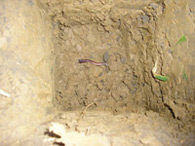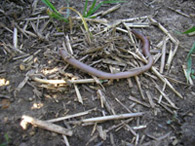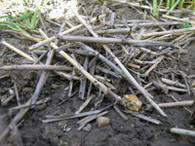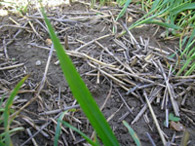‘If you look after your soil, the crops look after themselves’ – not to mention your bank balance and the environment.
Simon Cowell, an all-arable farmer from Essex, has developed a no-till system for his tricky-to-farm land below sea-level on the Blackwater Estuary. His philosophy is simple – show respect for the soil by putting it first when planning your farming strategy.
‘I have a heavy clay loam which was high in magnesium, which made it sticky in moist conditions and baked hard when dry. I stopped ploughing some 13 years ago, because in a dry time after harvest I couldn’t get the plough in the ground and in a wet autumn I was trying to work in a claggy mess. Also, under the conventional regime there was no way I could contemplate spring crops, so I had a very short rotation of a rape and 2 wheats.’
‘When I first stopped ploughing I was doing a certain amount of discing and subsoiling, but soon realised that incorporating the straw into the top few inches of soil was a mistake. The newly sown seeds didn’t like it, the buried straw consumes valuable nitrogen, and by mixing weed seeds into the cultivated profile of the soil I was creating problems for the future.’
‘Keeping all the straw on the surface is the best way to encourage worm activity, it is acting as a mulch to retain moisture, and avoids diluting the beneficial effects of increasing the soil organic matter. By leaving weed seeds on the surface, they are easier and cheaper to control and I have reduced the stock of problem weed seeds more rapidly.’
‘In order to maximise all these benefits, I realised I needed to rake the straw, because my combine wasn’t spreading the straw evenly enough and I wanted to encourage weed-seed chit. Scratching the surface also disturbs slug activity. I have a home-made straw rake which I have now fine-tuned and has 72 tines over its 6m width, working very superficially. I always operate it at an angle to the stubble straight after harvest and then at least once more, on the opposite diagonal, a couple of weeks later. I then use a low dose of glyphosate just prior to drilling.’
‘The next challenge was to find a drill which would be capable of sowing under this mulch without bunging up or leaving seed in contact with the debris. My Unidrill disc drill was inclined to do the latter and the crops came up yellow in the autumn. When I saw the SimTech T-Sem at LAMMA four years ago, I thought the Aitchison boot mounted on its spring tine was just what I was looking for, because it creates an ideal environment for seed germination and rapid root establishment.’
‘I have now been pure direct drilling for three years and am very pleased with the drill. It even performs well when conditions are sticky. I am getting the same yields as previously at a far lower cost. I am having fewer problems with weeds and slugs are becoming less evident as the microbiological balance of my soil is improving and creating the right environment for their predators.’
‘I no longer need to subsoil because the earthworms are doing this work for me (see photos) and because I am improving the quality of my topsoil I am now able to grow spring crops of linseed and peas (see photo), thus extending my rotation and achieving better all-round diversity.’




‘Alongside the stubble rake and the SimTech drill other management changes have made important contributions to the evolution of my soil. I have been using gypsum, which is Calcium Sulphate, to adjust the magnesium/calcium ratio in the soil. The sulphur combines with magnesium to make magnesium sulphate which is very soluble and so leaches down through the soil profile while leaving the calcium in the top layer. Out of respect for the soil structure I never travel in the fields with grain trailers, keeping to the headland tramline at all times when loaded. Both my tractor and combine are equipped with Terra tyres (see photo). The light weight of the SimTech drill was a bonus factor in this respect too.’
‘The creation of my no-till system has been a fascinating experience in that I have learnt a lot about the soil and the microbiological life it contains. I believe that although this technique has been developed for the conditions here on my farm, the same principles would apply anywhere. It is sustainable and the soil can only improve the longer I practise the system. Due to the mulch carpet on the friable top layer of soil I can walk the fields in my ordinary shoes all year round, whereas previously, one would have ‘big boot’ after five paces!’